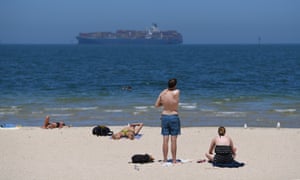Hottest month ever shows temperatures rising faster than predicted, say climate experts
Australia sweltered through the hottest month in its history in
January, spurring mass deaths of fish, fire warnings and concerns among
climate scientists that extreme heat is hitting faster and harder than
anticipated.
For the first time since records began, the country’s mean temperature in January exceeded 30C (86F), according to the Bureau of Meteorology (BoM), which said daily extremes – in some places just short of 50C – were unprecedented.
“There’s been so many records it’s really hard to count,” said Andrew Watkins, a senior climatologist at BoM, after January registered Australia’s warmest month for mean, maximum and minimum temperatures.
This followed the country’s warmest December on record, with heatwaves in every Australian state and territory. With colour-coded heat maps of the country resembling blazing red furnaces for much of the month, the authorities have recently issued a special report on the extraordinary heat.
A persistent high-pressure system in the Tasman Sea that blocked cold
fronts and cooler air from reaching the country’s south, and a delayed
monsoon in the north, contributed to the heatwave.For the first time since records began, the country’s mean temperature in January exceeded 30C (86F), according to the Bureau of Meteorology (BoM), which said daily extremes – in some places just short of 50C – were unprecedented.
“There’s been so many records it’s really hard to count,” said Andrew Watkins, a senior climatologist at BoM, after January registered Australia’s warmest month for mean, maximum and minimum temperatures.
This followed the country’s warmest December on record, with heatwaves in every Australian state and territory. With colour-coded heat maps of the country resembling blazing red furnaces for much of the month, the authorities have recently issued a special report on the extraordinary heat.

Tasmania, where emergency services have been battling bushfires throughout the past month, had its driest ever January. Watkins said Borrona Downs in north-west New South Wales broke the record for hottest minimum temperature, registering one night at 36.6C. This has a major impact on ecosystems that have not been able to cool down during the night as is normally the case.
This was compounded by drought. Large parts of Australia received only 20% of their normal rainfall, particularly throughout the south-east in Victoria and parts of NSW and South Australia.
More dead fish surface on the Darling River at Menindee – video
After the most recent fish die-off on 27 January, the Labor leader, Bill Shorten, said the Murray-Darling was “facing the makings of an ecological disaster”. He said: “This is not standard, this is not normal. This is a disaster.”
Cloncurry had 43 days in a row that exceeded 40C. Birdsville had 16 days in January of temperatures higher than 45C including 10 days in a row.
NSW, the Australian Capital Territory, Victoria and the Northern Territory all had their warmest January on record.

“Australia is already experiencing climate change now and there are impacts being experienced or felt across many communities and across many sectors,” said Helen Cleugh, the director of the Commonwealth Scientific and Industrial Research Organisation, which collaborated on the report.
The study, which is updated every two years, found that Australia’s fire seasons have lengthened – in places by months – and become more severe. From April to October, there has been a broad shift to more arid conditions in south-eastern and south-western Australia. Sea levels have already risen by 20cm and ocean temperatures are up by 1C, which is causing acidification – 10 times faster than at any time in 300m years – which has damaged the corals of the Great Barrier Reef.

No comments:
Post a Comment